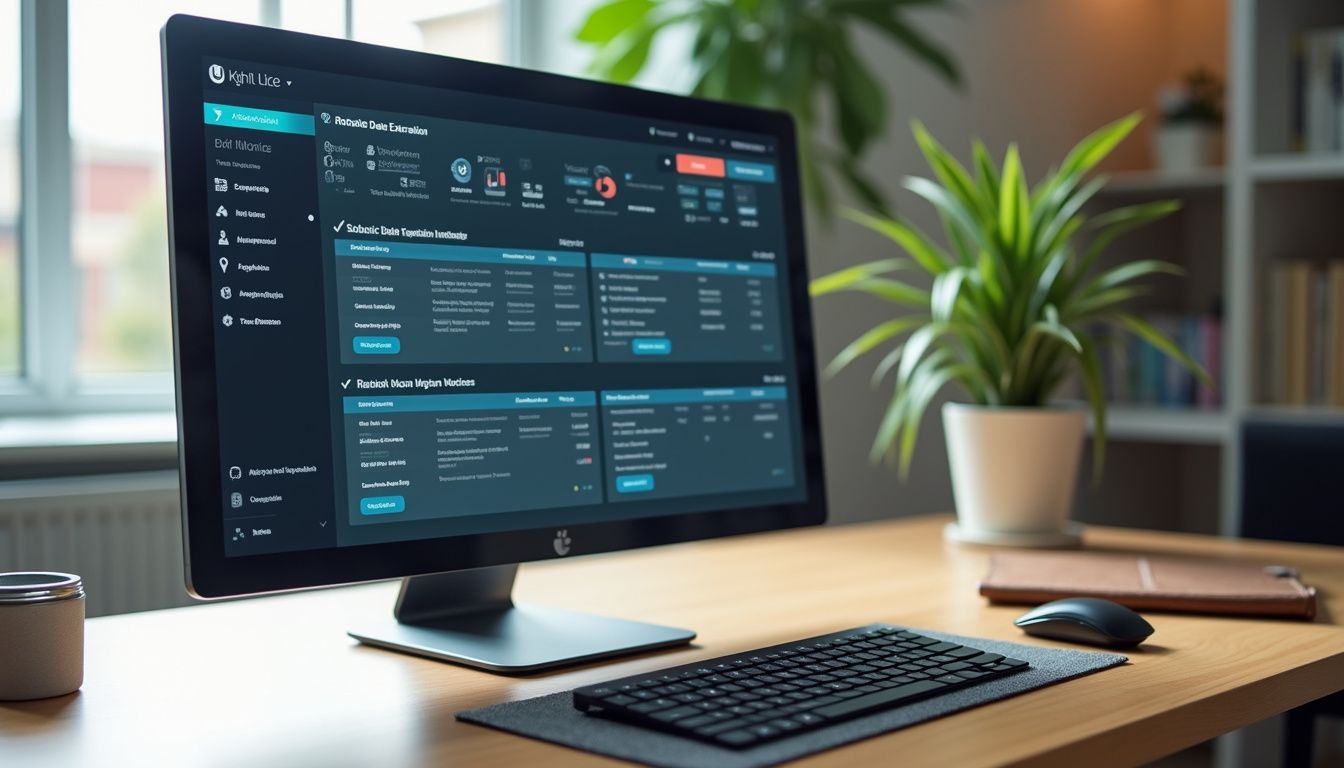Many of us find slow and error-prone business processes difficult, especially with tasks like accounts payable or document handling. These issues can be very frustrating and often hold up important work.
Research shows that manual cash application leads to mistakes and delays for many businesses. In this blog post, we explore how artificial intelligence (AI), robotic process automation (RPA), and digital transformation can work together to make daily tasks easier in areas such as ERP systems, data quality checks, electronic health records, dashboards, finance operations, cloud-based backups, scanning PDF invoices and spreadsheets.
If you wish to boost accuracy and speed up your company’s routine work, keep reading for useful insights.
Understanding the Trifecta: AI, RPA, and Digital Transformation
AI, RPA, and digital transformation work together to change how businesses operate. We use AI for smart decisions and RPA for automating tasks. Digital transformation ties it all together, helping companies adapt to new tools and technologies.
Defining Artificial Intelligence (AI)

Artificial intelligence uses machine learning to help us process data and make predictions. We train AI systems like Microsoft Dynamics 365, Workday, and QuickBooks with large datasets so they can spot patterns in both structured and unstructured data.
These tools can handle tasks such as analysing invoices, scanning PDFs, sorting emails from inboxes, or reading remittance advices with natural language processing and image recognition.
- Analysing invoices
- Scanning PDFs
- Sorting emails from inboxes
- Reading remittance advices
For example, these innovations flag anomalies in transaction databases efficiently.
AI helps auditors automate risk assessment by flagging anomalies found in transaction databases.
Our teams use artificial intelligence to improve internal controls through anomaly detection and accurate business forecasting. We often integrate these solutions using application programming interfaces to work seamlessly within existing enterprise resource planning systems.
What is Robotic Process Automation (RPA)?

After exploring Artificial Intelligence, we now look at Robotic Process Automation, or RPA. We use RPA to automate simple and repetitive jobs across software like Excel, enterprise resource planning systems such as PeopleSoft, cloud infrastructure platforms, and other computer applications.
Our bots work by copying how people interact with user interfaces instead of needing deep system integration. This means we do not have to overhaul our IT setup.
We rely on RPA for tasks like data extraction from invoices in XML or scans, processing accounts receivable entries in ERP systems, handling debit memos and credit cards transactions through automated clearing house networks or wire transfers, and scheduling routine reports on key performance indicators (KPIs).
- Data extraction from invoices
- Processing accounts receivable entries
- Handling debit memos and credit card transactions
- Scheduling routine KPI reports
With clear remittance advice, bots can automate up to 60% of cash application transactions. We also link APIs for electronic data interchange between Software-as-a-Service subscriptions without much custom coding. Audit trails help us maintain compliance with standards including IFRS during external audits. While RPA boosts speed and accuracy while cutting expenses and errors for fast ROI, it cannot handle messy unstructured data or learn over time like real artificial general intelligence (agi) solutions.
Instead, bots fill gaps left by traditional automation tools making system integration faster and more flexible for our business functions.
The Role of Digital Transformation in Modern Business

Robotic Process Automation helps us automate simple tasks, yet digital transformation takes our progress much further. By adopting enterprise resource planning software and Software-as-a-Service tools, we streamline operations and connect our teams.
We break down silos with integrated systems like ERPs and cloud platforms.
Moving to SaaS gives us scalability, multi-currency support, and easier global rollout. Real-time dashboards show cash flow as it happens. We use intelligent document processing for receivables to reduce Days Sales Outstanding (DSO). Strong backup and recovery keep our data safe through every migration or upgrade. With metrics from advanced analytics at our fingertips, we make fast, data-driven decisions that boost operational efficiency and customer experience while staying adaptable in a changing market.
AI + RPA: A Powerful Synergy

AI and RPA work well together. RPA automates boring tasks while AI helps with smart choices. This mix leads to better efficiency and faster workflows in business.
RPA’s Capabilities in Automating Repetitive Tasks

RPA automates data entry, ingestion and reconciliation across enterprise resource planning (ERP) or accounting platforms like SAP, Oracle, NetSuite and QuickBooks. We use it to match invoices with payments using rule-based processing.
RPA also downloads bank statements, processes electronic remittances and manages basic deductions faster than any manual method. Tasks that took hours now finish in minutes.
Our teams benefit from digital audit trails for compliance and governance needs. Automation scales up during peak periods so our operations keep pace with business growth without extra hires.
With RPA handling repetitive tasks, we free up subject matter experts for more value-driven work. Next, we will see how artificial intelligence improves decision-making alongside these automated systems.
The Role of AI in Enhancing Decision-Making

AI uses machine learning to spot patterns from past transaction data. We can make better decisions as AI provides predictive matching, confidence scoring, and multi-criteria matching for quick reconciliation.
Our teams use intelligent automation tools like computer vision and natural language processing in intelligent document processing (IDP) to extract semi-structured and unstructured data from invoices or contracts.
This helps us route disputes fast, manage risks, and get real-time insights with AI-powered dashboards.
Using predictive analytics, we forecast business trends and improve cash flow management. Customisable reports help us track performance across all touchpoints. We optimise operations while meeting data privacy rules through secure software-as-a-Service (SaaS) models and blockchain technology for added security.
AI gives us the power to turn big data into smart action points.
With these tools, our decision-making is faster, more accurate, and always backed by live data. These advancements have allowed us to scale up operations significantly.
Combining AI and RPA: The Path to Hyperautomation

AI helps us make smarter decisions. Now, we will see what happens as we connect it with robotic process automation for hyperautomation. In cash application processes, AI and RPA together push automation rates above 90 percent. This makes large-scale data migration much faster and more accurate.
Our teams benefit when RPA bots handle repetitive jobs while artificial intelligence flags exceptions using smart routing and centralised worklists. Hyperautomation allows real-time integration with top ERPs like SAP, Oracle, NetSuite, and Microsoft Dynamics 365.
We can scale up across many entities worldwide because of this strong combination. Automated workflows support AR specialists so they spend less time on manual work and focus on higher-value tasks that drive better return on investment. These tools reduce the resources we need while helping us manage semi-structured data quickly in intricate business environments such as those supporting UPI payments or multi-entity operations.
Customisable solutions allow each company to adapt its workflow needs without losing speed or accuracy. These systems remain highly customizable to meet diverse organisational requirements.
Core Applications of AI and RPA in Business

AI and RPA work together in many key areas to make business smarter. They help with tasks like data entry, customer service, and fraud detection. Chatbots answer questions fast. AI spots risks before they become big problems.
These tools save time and improve results for companies. The benefits include:
- Automated data entry and processing
- Enhanced customer service with chatbots and virtual assistants
- Improved fraud detection and risk management
- Advanced analytics and business forecasting
Want to find out more about these exciting applications?
Automating Data Entry and Processing

RPA tools collect data directly from bank feeds, emails, web portals, EDI and API connections, as well as scanned or physical documents. We use these bots to enter information into enterprise resource planning (ERP) systems. This reduces manual work and cuts down on mistakes that often slow us down.
With intelligent document processing powered by artificial intelligence, we extract details from unstructured or semi-structured sources fast. Automation ensures less unapplied cash and keeps our accounts receivable balances accurate at all times. Real-time synchronisation with accounting software boosts our visibility over company cash flow.
Our processes now support multi-entity operations and handle multiple currencies due to bidirectional system integration.
By automating data entry with RPA and AI-driven IDP, we improve accuracy while freeing staff for higher-value tasks.
We see how this technology improves retention rates because staff are less bogged down by repetitive jobs. Next up is the way chatbots and virtual assistants drive smarter customer service using these same powerful tools.
Intelligent Customer Service with Chatbots and Virtual Assistants

After automating data entry and processing, we can use chatbots and virtual assistants to improve customer service. AI powers these tools so they answer questions fast and give clear help every time.
In healthcare, hospitals use AI chatbots for patient support. Retail stores use them to handle customer requests any hour of the day. We scale up our service without hiring more staff by using chatbots that work round the clock.
Automated exception management tools give team members a central place to track issues and share updates in real time. With AI-driven platforms like IBM Watson Assistant or Microsoft Azure Bot Service, we easily customise chatbot responses so customers get what they need quickly. These systems detect complaints or disputes, sort them automatically, then send each case to the right team for quick solutions.
Quicker response times increase satisfaction because people get answers right away instead of waiting hours or days. By linking artificial intelligence with prompt technologies such as cloud-based assistants from Amazon Alexa for Business, we make sure our business stays flexible and efficient as we grow.
This approach helps us keep errors low while supporting larger numbers of customers at once.
Fraud Detection and Risk Management

Automated validation and monitoring in cash application help us prevent fraud and avoid regulatory breaches. We use real-time dashboards to spot anomalies fast, so we can react before problems grow.
Data encryption, PCI DSS and GDPR or CCPA compliance keep sensitive information secure at all times. Audit trails let us track every change, making audits simple while cutting regulatory risk.
Automated controls strengthen internal checks; this lowers the chance of errors or manipulation by staff or outsiders. Artificial intelligence tools like anomaly detection work with RPA to catch risky actions early, allowing scalable security as we grow.
These systems are customisable for our business needs, helping meet stricter standards without slowing down our work.
Advanced Analytics and Business Forecasting

Real-time dashboards give us clear KPIs and instant reports. We spot trends early, which helps with business forecasting. Centralised data repositories let us track performance and compare results across teams or periods.
We use analytics tools like Microsoft Power BI and Tableau to make sense of large amounts of information. AI-driven cash flow forecasting supports our liquidity planning and working capital management. Accurate real-time data boosts our financial visibility for smarter decisions. Automated reconciliation and audit trails keep financial reporting error free.
With these tools, we can scale up fast and stay ready for growth as digital transformation moves forward.
Digital Transformation: Driving Change Across Industries

Digital transformation is changing how industries operate. It helps businesses use technology to make tasks easier and faster. Companies are creating better experiences for their customers through digital tools. Smart systems can break down barriers within organisations, making teamwork smoother.
Streamlining Operations with Technology
We use technology to streamline our operations. Automation makes our processes faster and easier. It cuts down on manual work like data entry and reconciliation in accounts receivable and payable.
With rule-based cash receipt application and payment matching, we boost efficiency. Automated exception management centralises issue resolution, saving time for our team.
Cloud-based software as a service (SaaS) gives us multi-currency and multi-language support. Centralised dashboards allow real-time monitoring of operations. We can see what is happening right away; this improves our control over tasks.
Intelligent automation helps reduce the resource drain caused by manual processes, allowing us to focus on more important work now.
Enhancing Customer Experiences Through Digital Solutions
Streamlining operations leads us to enhance customer experiences through digital solutions. AI-powered matching and reconciliation give us immediate cash application. This process benefits our customers like never before.
Automated follow-ups keep our communication clear and effective, boosting satisfaction. Digital solutions offer real-time status visibility for our clients. Faster dispute resolution becomes possible with these tools, making their experience smoother. Personalised marketing comes alive thanks to AI insights, ensuring we meet customer needs efficiently.
Capturing early payment discounts is easier because of accelerated cash flow processes; this adds value for both the business and the client as we grow together.
Breaking Down Organisational Silos with Integrated Systems
Integrated systems help us break down organisational silos. Bidirectional ERP integration links finance, accounts receivable, and operations. This connection allows different teams to work together easily.
Centralised worklists and collaboration tools foster alignment across departments. Automated data synchronisation eliminates information silos and duplication.
Multi-entity and global support enable unified operations across regions. Real-time analytics and dashboards provide shared visibility for all stakeholders. These features make our businesses more adaptable.
They also enhance decision-making by allowing us to see the full picture clearly. As we explore benefits of AI, RPA, and digital transformation in business growth next, we can further understand how integrated systems drive success.
Benefits of AI, RPA, and Digital Transformation in Business Growth

AI, RPA, and digital transformation help organisations work better and save money. They make tasks quicker and more accurate. We can grab real-time data to make smarter choices. These tools also allow businesses to grow easily and adapt to changes in the market.
Want to learn how they boost your business even more? Keep reading!
Improved Operational Efficiency
Operational efficiency improves significantly with AI and RPA. Processing times for tasks like cash application drop from hours or days to just minutes. We can automate payment matching, posting, and reconciliation in finance. This reduces the time needed for these activities.
RPA and AI also eliminate bottlenecks in high-volume work. They make processes less labour intensive. With automated exception management and workflow tools, we address challenges quickly. Scalable solutions allow us to manage peak transaction volumes without needing extra resources; this greatly boosts our productivity.
Cost Savings and Resource Optimisation
Cost savings and resource optimisation are key benefits of using AI and RPA together. We see a significant reduction in manual labour and administration costs. These technologies allow for proactive cash matching, which lowers investigation time and reduces rework. Using automation frees our accounts receivable specialists to focus on tasks that add real value.
SaaS and cloud deployment cut down on infrastructure investments. Automation helps us manage multi-entity operations without needing more staff. This means we can use our resources more wisely. Next, we will explore the many ways AI and RPA can transform core applications in business.
Enhanced Accuracy and Reduced Errors
Enhanced accuracy in data entry makes a significant difference. It minimises mistakes when matching payments. Automated validation and clear audit trails assist us in preventing problems in financial reports. Intelligent automation ensures our data remains consistent across different systems.
Proactive error detection reduces the need for manual corrections and rework. AI-driven matching also decreases exceptions related to missing or inconsistent remittance advice. We observe fewer discrepancies, making our processes more efficient and dependable as we scale up our operations with these tools.
Faster Decision-Making with Real-Time Insights
Real-time dashboards give us up-to-date key performance indicators and clear cash flow visibility. This helps in spotting trends and issues quickly. AI-powered analytics support rapid forecasting, allowing us to plan better for different scenarios. With automated reporting, we can ensure timely compliance and audit activities. Performance monitoring tools drive our leadership decisions by providing the right information at the right time.
These insights help streamline operations and boost growth across teams. Next, we will explore core applications of AI and RPA in business.
Better Scalability and Flexibility for Businesses
Cloud-based solutions help our businesses grow. They adapt easily to changing needs and demands. This flexibility means we can scale up operations smoothly without major disruptions. Processes become automated, which allows us to handle more transactions as our business expands.
Multi-currency and multi-language support opens doors for global reach. We can enter new markets while maintaining consistent service quality. Integration with popular ERP and accounting systems supports various business models too. Scalable exception management ensures that performance stays steady, even during busy times. This balance of efficiency makes growth easier for us all.
Key Use Cases of AI and RPA in Digital Transformation

Key use cases of AI and RPA in digital transformation show how businesses can boost efficiency. They streamline processes like invoicing or supply management. This helps teams work faster and smarter. The main applications include:
- Automating accounts payable and receivable processes
- Enhancing supply chain management with AI
- Improving workforce management and employee onboarding
- Personalising marketing campaigns with AI insights
- Optimising IT operations through predictive maintenance
Want to find out more about these exciting applications?
Automating Accounts Payable and Receivable Processes
Automating accounts payable and receivable processes boosts our financial efficiency. We can match incoming payments to AR invoices, which improves liquidity. RPA processes remittances from bank feeds, emails, and portals. This saves us time and reduces errors in tracking payments.
AI and machine learning help with predictive matching of transactions. They learn continuously from transaction data. Exception management tools speed up deduction and dispute resolution too. Real-time synchronisation with our enterprise resource planning systems ensures accurate financial postings as well. Automation cuts down unapplied cash while preparing us for audits easily.
Enhancing Supply Chain Management with AI
AI improves supply chain management in many ways. AI-driven analytics help us forecast demand and optimise inventory levels. This means we can keep the right stock on hand, reducing waste. Predictive matching and reconciliation minimise delays in our supply chains. We automate data extraction from supplier invoices and remittances to speed up processing times.
Centralised dashboards give us clear visibility across the entire network, helping us make better decisions quickly. AI supports risk identification in procurement and logistics, which keeps our operations smooth and secure.
Workforce Management and Employee Onboarding Automation
We automate routine HR tasks like payroll and data management with RPA. This makes workflows smoother and saves time. Digital onboarding platforms help new hires complete paperwork quickly. These platforms handle documentation and compliance efficiently.
Automated exception routing ensures we resolve onboarding issues on time. AI tools match candidate skills to job needs, making recruitment faster. Employees feel happier with less manual work and quicker integration into the team.
Such changes lead to better workforce management and employee satisfaction as we scale up in our business growth journey.
Personalising Marketing Campaigns with AI Insights
AI helps us understand customer behaviour better. It allows us to tailor our marketing messages and offers for each person. Using real-time analytics, we can change campaigns quickly based on what customers want. Automated data segmentation supports our multi-channel strategies, making sure the right message reaches the right people at the right time.
With AI-powered dashboards, we track how well our campaigns are doing. We see performance and return on investment clearly. Personalisation boosts customer satisfaction and helps keep them coming back for more. This way, we scale up our efforts while delivering customisable content that truly resonates with our audience.
Optimising IT Operations Through Predictive Maintenance
Predictive maintenance transforms IT operations using AI to foresee equipment failures before they happen. This means we schedule proactive fixes instead of waiting for issues to arise. Automated alerts and workflows keep our systems running smoothly. They cut down on IT downtime and lower support costs.
Centralised monitoring tools give us real-time health analytics of systems. We can make smarter investments in our infrastructure using predictive analytics. Automation supports IT governance and security standards, ensuring everything runs safely and efficiently.
Overcoming Challenges in Implementing AI, RPA, and Digital Transformation

Implementing AI, RPA, and digital change can be tricky. We face issues like data safety and getting everyone on board with new tools. It is also hard to connect new systems with older ones that are still in use. Businesses need to consider costs versus benefits for these tech choices. Want to learn more about how we can tackle these challenges?
Addressing Data Privacy and Security Concerns
Data privacy and security are vital in our digital world. We must protect sensitive financial and customer data. Data encryption keeps this information safe from threats. Automated controls ensure we comply with standards like PCI DSS, GDPR, and CCPA. These rules help us manage data responsibly.
We also create audit trails to support fraud prevention. Internal controls play a key role in meeting regulatory requirements. Backup and recovery protocols are crucial for business continuity; they keep our operations running smoothly during unexpected events. Centralised security monitoring helps us detect threats in real time, allowing us to act quickly to protect our systems from harm.
Managing Change and Employee Upskilling
Addressing data privacy and security concerns leads us to managing change and employee upskilling. Leadership commitment is key for our digital transformation success. We need to support employees through training as they adjust to new technologies. Upskilling helps our team focus on strategic roles and alleviates repetitive tasks. Automation reduces burnout by taking over tedious work. Change management plans involve input from all stakeholders, ensuring a smoother transition. Continuous feedback helps us adapt and improve how we use these tools in our daily operations.
Ensuring Seamless Integration with Legacy Systems
We assess legacy system compatibility during automation planning. This step is crucial to ensure smooth integration with our current tools. API integration connects RPA and AI solutions with existing ERP and accounting platforms. We employ bidirectional data synchronisation, which keeps information consistent across all systems. Multi-entity and multi-currency support help us manage operations more effectively, especially for businesses that operate globally. A phased implementation approach minimises disruption while maximising ROI. By taking these steps, we create a seamless transition that boosts our productivity without major interruptions.
Balancing Costs and ROI in Technology Investments
Balancing costs and return on investment (ROI) is vital for successful technology investments. We set SMART automation objectives that focus on reducing unapplied cash and increasing automation rates. This helps us target specific financial goals while implementing new tools like AI and RPA. Budget allocation covers software, integration, training, and maintenance costs to ensure we stay within limits. Phased implementation allows incremental value realisation. We can track progress through real-time dashboards that monitor ROI and performance metrics closely. Continuous optimisation ensures we sustain these benefits while controlling expenses effectively. Investing in the right technologies leads to improved efficiency and cost savings in the long run as businesses scale up their operations.
The Future of AI, RPA, and Digital Transformation

The future of AI, RPA, and digital transformation holds exciting promise. We can expect to see hyperautomation leading the charge in business efficiency. Generative AI will reshape how we create content and strategies. Predictive analytics will help companies make real-time decisions that drive growth. Blockchain technology is set to impact many aspects of digital change too.
Hyperautomation as the Next Frontier
Hyperautomation represents a big step forward for businesses. It combines AI and RPA to automate more than 90% of operational processes. This means we can streamline tasks that once took a lot of time and effort. With human-in-the-loop systems, machine learning becomes better over time, leading to greater accuracy in our work.
Many companies can now support global operations with ease thanks to hyperautomation. We benefit from improved exception management and workflow automation, which drive continuous process improvement. Integrated analytics provide us with actionable insights for decision-making at the leadership level. As we embrace these changes, scalability becomes key for our growth strategy.
The Rise of Generative AI in Business Applications
The shift to hyperautomation leads us to the rise of generative AI in business applications. Generative AI is transforming how we analyse data and create content. It makes advanced analytics simple and effective. Businesses can automate many tasks with these tools. AI-enabled systems assist in categorising financial deductions and resolving disputes quickly. They also enhance personalised marketing efforts, making customer engagement more effective.
In sectors like healthcare, chatbots and virtual assistants improve service delivery. Predictive matching streamlines processes while intelligent document processing boosts accuracy across different functions, supporting our goal for scalable solutions in the workplace.
Predictive Analytics and Real-Time Decision-Making
Predictive analytics plays a key role in decision-making. AI-driven predictive analytics helps us forecast cash flow and allocate resources wisely. Real-time dashboards provide current key performance indicators (KPIs). This enables quick and informed decisions.
We can adjust to market changes with automated scenario planning. Predictive maintenance improves IT reliability by reducing downtime. Centralised data allows us to monitor operational and financial trends effectively. These tools empower us to make swift choices based on timely insights.
The Impact of Blockchain on Digital Transformation
Blockchain plays a key role in digital transformation. It provides secure, decentralised ledgers that help reduce fraud. This builds confidence in transactions across industries. With blockchain, we can track items better in supply chains and finance.
Integrating blockchain with AI and RPA boosts audit readiness and compliance efforts. Future strategies will include blockchain for improved governance and efficiency. Our approach to digital change will be clearer and more transparent with these tools working together.
Conclusion

The blend of AI, RPA, and digital transformation drives business growth. We can improve efficiency and cut costs while enhancing accuracy. This trio helps us adapt quickly to changes.
By embracing these technologies, we elevate our operations and enrich customer experiences. Let’s seize this chance to thrive in a competitive market.
Disclosure: The content is provided for informational purposes only. The data was collected from publicly available sources. No affiliate or sponsorship disclosures apply.



.svg)










